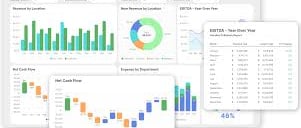The Numbers Don’t Have to Be Numb-ing:
A Simple Guide to Reading Your Business Reports
Alexis Stuart Dudley
10/24/20253 min read


You know that moment when you open QuickBooks, click on “Reports,” and your brain immediately whispers nope? You’re not alone.
Most small business owners I meet didn’t start their business to become accountants — and yet, somewhere between invoicing clients, paying bills, and filing taxes, they end up staring down a Profit & Loss report wondering what in the world it’s trying to say.
Here’s the truth: your numbers aren’t trying to confuse you. They’re trying to tell you a story — one about where your business has been, where it’s heading, and how to steer it with confidence.
Let’s walk through the key reports every business owner should review (and what they’re actually saying, in plain English).
1️⃣ Profit & Loss: Your Business’s Heartbeat
If you only look at one report, make it this one.
Your Profit & Loss (P&L) — also called an Income Statement — shows how much you earned and how much you spent over a specific period. It’s the financial pulse of your business.
Here’s the simple breakdown:
- Income = money coming in (sales, client payments, commissions)
- Expenses = money going out (subscriptions, rent, payroll, etc.)
- Net Profit = what’s left over when all the bills are paid
You don’t need to analyze every single line item — just look for patterns. Is your income trending upward? Are certain expenses growing faster than sales?
✅ Tip: “Your P&L isn’t judging you — it’s guiding you. Use it to ask better questions, not to beat yourself up.”
Bonus Tip: Look at your Net Profit Margin (Net Profit ÷ Total Income). If you’re consistently below 10%, it’s time to explore where expenses can be tightened or pricing adjusted.
2️⃣ P&L Year-to-Date Comparison: Seeing the Story Arc
A single month of data can lie to you.
Maybe January was slow because everyone was still on holiday mode, or maybe June boomed because you landed that big client. That’s why I love the Profit & Loss Year-to-Date Comparison report — it gives you context.
This report shows your results so far this year compared to the same period last year (or even the previous month). It’s one of the best tools for spotting trends.
Look for:
- Seasonal patterns (Are there months when sales always dip?)
- Expense creep (Are software or materials costs quietly increasing?)
- Momentum (Are you growing faster than last year?)
✅ Tip: “Numbers tell a story — this report shows the plot twist. It’s where you realize how far you’ve actually come.”
3️⃣ Balance Sheet: The Snapshot of Stability
If the P&L shows movement over time, your Balance Sheet shows the still frame — a moment in time that tells you what your business owns, owes, and is worth.
It’s divided into three main parts:
- Assets – What you own (cash, equipment, accounts receivable)
- Liabilities – What you owe (credit cards, loans, unpaid bills)
- Equity – What’s left after subtracting liabilities from assets — essentially, your business’s “net worth.”
If you’re a service-based business or solo entrepreneur, this report may feel less exciting, but it’s essential. It shows your financial stability — whether your assets can cover your obligations if things get tight.
✅ Tip: “Think of your Balance Sheet like a mirror. It reflects the true health of your business, not just how busy you’ve been.”
4️⃣ General Ledger: The Detective Work Report
The General Ledger (GL) is where every single transaction lives — the full detail behind your financial story. It’s not glamorous, but it’s powerful.
This is where you go when something on your P&L or Balance Sheet doesn’t make sense. Maybe an expense landed in the wrong category, or income was duplicated. The GL helps you trace the breadcrumbs.
✅ Tip: “If your reports look ‘off,’ your General Ledger is the scene of the crime. It’s where you find the why.”
5️⃣ The Clean Books Mindset
Here’s what I tell every client: clean books aren’t just about compliance — they’re about clarity.
When your reports are accurate and you actually understand them, something amazing happens:
- You make decisions faster.
- You stop guessing.
- You start planning like a CEO, not reacting like a firefighter.
Your reports become a tool for empowerment — not a punishment for procrastination.
And when you finally reach the point where reviewing your numbers feels easy, you’ll realize: this is what peace of mind in business looks like.
✅ Tip: “Clean books tell a clean story. And a clean story helps you write your next chapter with confidence.”
Ready to See Your Numbers in a New Light?
If you’ve been avoiding your reports because they feel overwhelming or confusing, it’s okay — most business owners do. But you don’t have to stay stuck in that fog.
At Stuart + Dudley Bookkeeping, I help entrepreneurs turn their financial data into clear, actionable insight. Together, we’ll create systems that make sense, reports that tell the truth, and decisions that feel grounded in real numbers — not guesswork.
Because when you understand your books, you can finally run your business with clarity, confidence, and calm.
For the Love of Clean Books,
Alexis
? ? ?